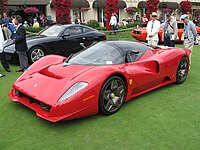For a complete list, including future and concept car models, see List of Ferrari road cars.

Ferrari's first vehicle was the 125S sports/racing model. In 1949, the Ferrari 166 Inter, the company's first move into the grand touring market, which continues to make up the bulk of Ferrari sales to the present day.
Several early cars featured bodywork customised by a number of coachbuilders such as Pininfarina, Zagato and Bertone.
The Dino was the first mid-engined Ferrari. This layout would go on to be used in most Ferraris of the 1980s and 1990s. V6 and V8 Ferrari models make up well over half of the marque's total production.
For a time, Ferrari built 2+2 versions of its mid-engined V8 cars. Although they looked quite different from their 2-seat counterparts, both the GT4 and Mondial were closely related to the 308 GTB.
The company has also produced front-engined 2+2 cars, culminating in the current 612 Scaglietti and upcoming California.
Ferrari entered the mid-engined 12-cylinder fray with the Berlinetta Boxer in 1973. The later Testarossa remains one of the most famous Ferraris.
Supercars
The company's loftiest efforts have been in the supercar market. The 1962 250 GTO may be considered the first in the line of Ferrari supercars, which extends to the recent Enzo Ferrari and FXX models.
Concept cars and specials
Ferrari has produced a number of concept cars, such as the Ferrari Mythos. While some of these were quite radical (such as the Ferrari Modulo and never intended for production, others such as the Ferrari Mythos have shown styling elements which were later incopoprated into production models.
The most recent concept car to be produced by Ferrari themselves was the 2005 Ferrari Ascari.
A number of one-off special versions of Ferrari road cars have also been produced, some of which have been commissioned by wealthy owners.
Naming conventions
Until the early 1980s, Ferrari followed a three-number naming scheme based on engine displacement:
- V6 and V8 models used the total displacement (in decilitres) for the first two digits and the number of cylinders as the third. Thus, the 206 was a 2.0 L V6 powered vehicle, while the 348 used a 3.4 L V8, although, for the F355, the last digit refers to 5 valves per cylinder. Upon introduction of the 360 Modena, the digits for V8 models (which now carried a name as well as a number) refer only to total engine displacement. The numerical indication aspect of this name has carried on to the current V8 model, the F430.
- V12 models used the displacement (in cubic centimetres) of one cylinder. Therefore, the famed 365 Daytona had a 4390 cc V12. However, some newer V12-engined Ferraris, such as the 599, have three-number designations that refer only to total engine displacement.
- Flat 12 (boxer) models used the displacement in litres. Therefore, the 512BB was five litre flat 12 (a Berlinetta Boxer, in this case). However, the original Berlinetta Boxer was the 365 GT4 BB, which was named in a similar manner to the V12 models.
- Some models, such as the 1980 Mondial and the 1984 Testarossa did not follow a three-number naming scheme.

Most Ferraris were also given designations referring to their body style. In general, the following conventions were used:
- M ("Modificata"), placed at the end of a model's number, denotes a modified version of its predecessor and not a complete evolution (see F512M and 575M Maranello).
- GTB ("Gran Turismo Berlinetta") models are closed Berlinettas, or coupes.
- GTS ("Gran Turismo Spyder") in older models, are open Spyders (spelt "y"), or convertibles (see 365GTS4); however, in more recent models, this suffix is used for targa top models (see Dino 246GTS, and F355 GTS; the exception being the 348 TS, which is the only targa named differently). The convertible models now use the suffix "Spider" (spelt "i") (see F355 Spider, and 360 Spider).
This naming system can be confusing, as some entirely different vehicles used the same engine type and body style. Many Ferraris also had other names affixed (like Daytona) to identify them further. Many such names are actually not official factory names. The Daytona name commemorates Ferrari's triple success in the February 1967 24 Hours of Daytona with the 330P4[5]. Only in the 1973 Daytona 24 Hours, a 365 GTB4 model run by NART, who raced Ferrari's in America) ran second, behind a Porsche 911[6].
The various Dino models were named for Enzo's son, Dino Ferrari, and were marketed as Dinos by Ferrari and sold at Ferrari dealers—for all intents and purposes they are Ferraris.
In the mid 1990s, Ferrari added the letter "F" to the beginning of all models (a practice abandoned after the F512M and F355, but adopted again with the F430).





0 comments:
Post a Comment